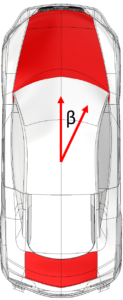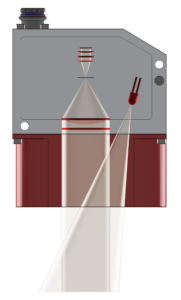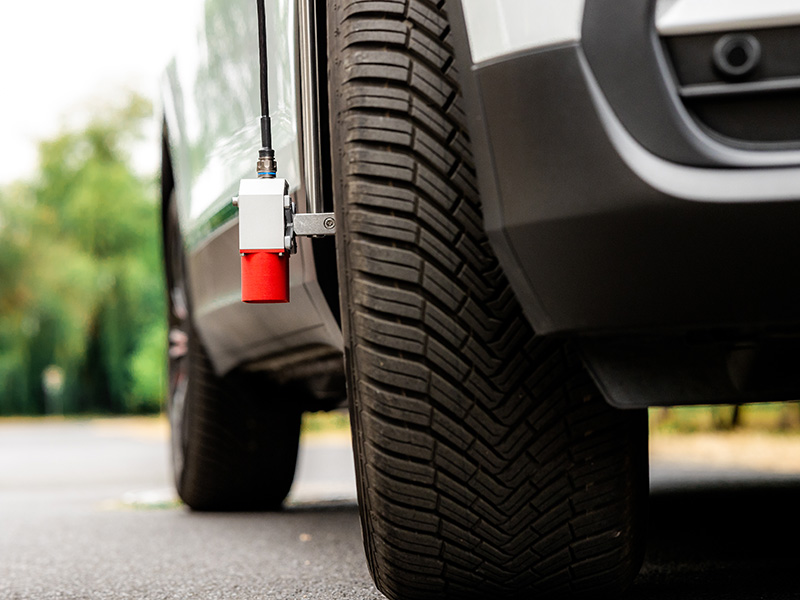Whether in the development of new vehicles, in racing or in autonomous systems – if you want to understand how a vehicle moves on the road, you have to determine the direction of movement precisely. Two angles play a decisive role here: the slip angle and the slip angle (wheel). They provide deeper insights into vehicle dynamics and help to significantly improve handling, safety and performance.
What is the slip angle (car)?

Slip angle β (car)
The slip angle describes the angle between the direction of movement of the vehicle’s center of gravity and its longitudinal axis. In short, it indicates how much the vehicle “floats”, i.e. drifts perpendicular to the longitudinal axis. This angle is particularly relevant in dynamic maneuvers, such as sudden evasive movements or driving on slippery surfaces.
Since a direct measurement at the center of gravity is often not possible, the slip angle can also be measured at other points on the vehicle and then calculated back to the center of gravity using known movement variables such as rotation rate and speed.
What is the slip angle (wheel)?

Slip angle of the wheel
The slip angle is the angle between the steering angle and the direction of movement of the wheel
The slip angle occurs on the tires whenever the vehicle is cornering. It describes the angle between the actual direction of movement of the wheel and its alignment (steering angle). This deviation is caused by the elastic deformation of the tire contact patch and is closely linked to the lateral guidance force that a tire can build up.
If the sensor is mounted directly on the wheel, this angle can be measured precisely. In practice, the slip angle is essential for the development of vehicle dynamics systems, for example:
- ESP / ABS / TCS
- Lane departure warning system and lane departure warning system
- Autonomious vehicles
- Racing optimization
How are slip angles measured?
 Indirect measurement with inertial systems
Indirect measurement with inertial systems
One widely used method is the use of inertial systems that combine acceleration and angular rate sensors with GPS. These systems record the vehicle movement on the basis of integrated sensor signals. The slip angle is not measured directly, but calculated from the movement data. The advantages of these systems are the large number of measured variables they provide. However, they also have clear limitations:
- Only reliable when driving dynamically: The calculation of the float angle requires sufficient acceleration – the measurement is unreliable or not possible when driving slowly.
- High power consumption: Systems typically require up to 30 W, which impairs energy efficiency.
- High mass: Platforms weigh up to 3.5 kg, which makes integration into certain applications more difficult.
- Wheel mounting often impractical: The systems are typically installed inside the vehicle – mounting on the wheel to detect the slip angle is difficult to implement.
Direct measurement with optical sensor
 In contrast, optical measurement is based on the direct detection of road movement using image processing or spatial frequency methods. The road surface is recorded visually and analyzed image by image. The change in structural points enables the precise calculation of speed and direction of movement – and thus of the slip and slip angle. This method is contactless, slip-free and delivers exact results, regardless of the vehicle speed.
In contrast, optical measurement is based on the direct detection of road movement using image processing or spatial frequency methods. The road surface is recorded visually and analyzed image by image. The change in structural points enables the precise calculation of speed and direction of movement – and thus of the slip and slip angle. This method is contactless, slip-free and delivers exact results, regardless of the vehicle speed.
And: only the optical method measures the float angle directly. The OMS 7 from Sensoric Solutions achieves an exceptional accuracy of better than 0.1° – without any detours via model calculations or external support signals.
Why the OMS 7 from Sensoric Solutions is the ideal sensor
The OMS 7 optical sensor from Sensoric Solutions was specially developed for measuring vehicle movement based on the proven spatial frequency method. Its design and properties make it the ideal choice for demanding measurement tasks:
- Direct, non-contact measurement with up to 1 kHz update rate – ideal for highly dynamic driving maneuvers
- High accuracy: speed better than 0.2 %, float angle with a precision of up to 0.1°
- Universal mounting on the vehicle or directly on the wheel ( with collets, magnetic or suction holders)
- Reliability even in tunnels, urban areas or with poor GPS reception
- Fast operational readiness: no initialization necessary
- Robust and compact: ideal for racing and field trials
- Energy-efficient: power consumption below 25 W, integrated UPS protects against undervoltage
What is particularly exciting is that the OMS 7 works on all road surfaces – from asphalt to concrete and gravel – and delivers precise values even where other systems have long since reached their limits.
Conclusion:
When it comes to the precise and reliable measurement of slip and slip angles, the OMS 7 from Sensoric Solutions is the clear choice. With its direct measuring principle, high dynamics and easy handling, it offers the perfect combination of practicality and technical precision – for anyone who does not compromise on driving dynamics.
